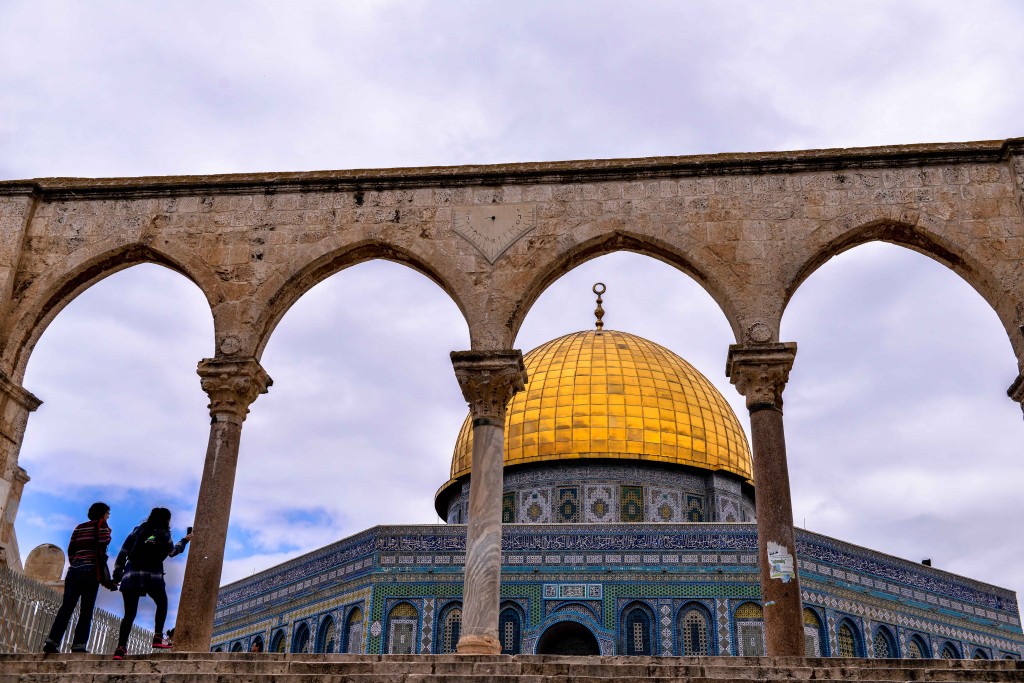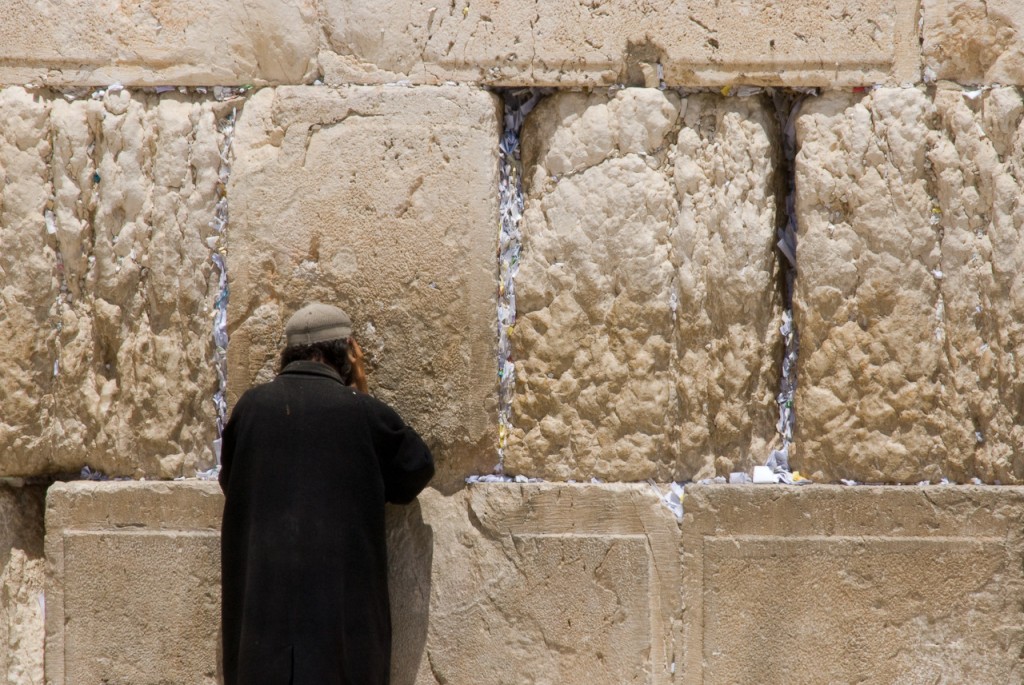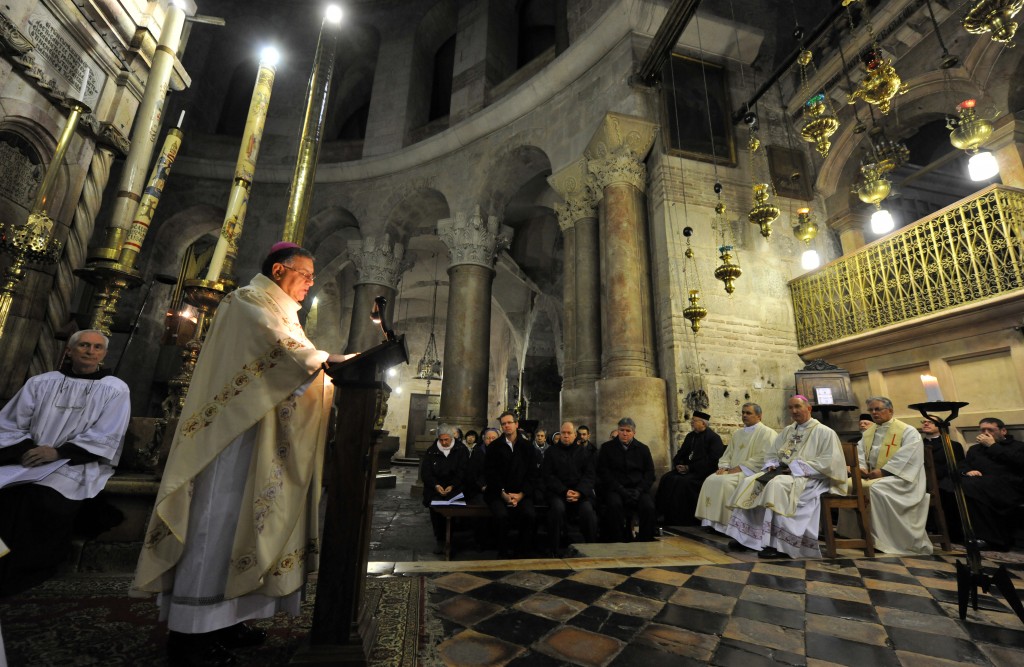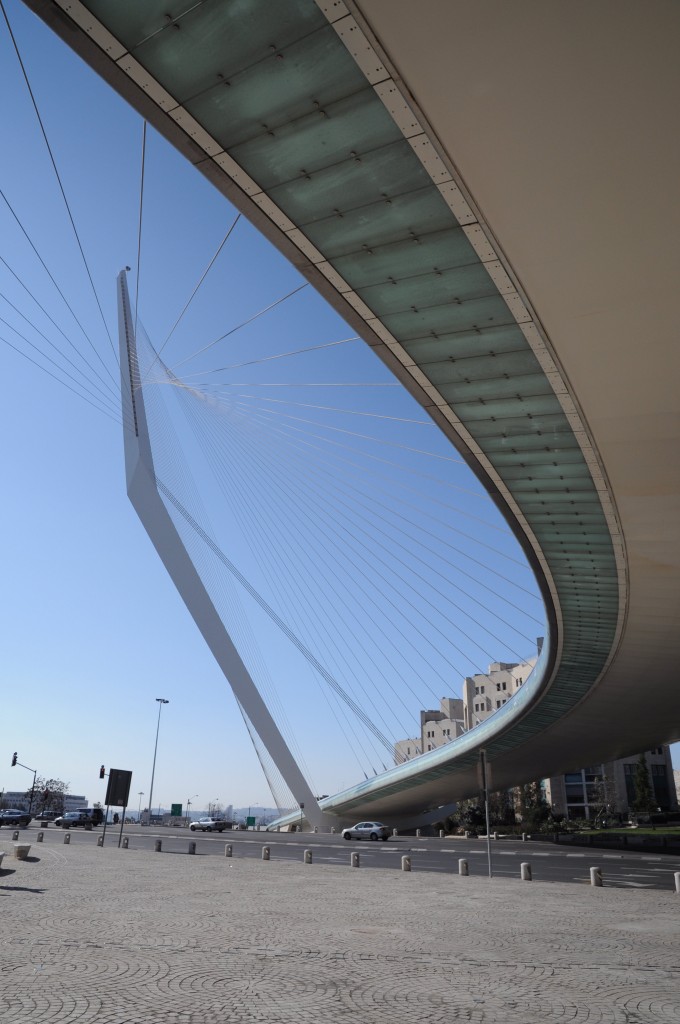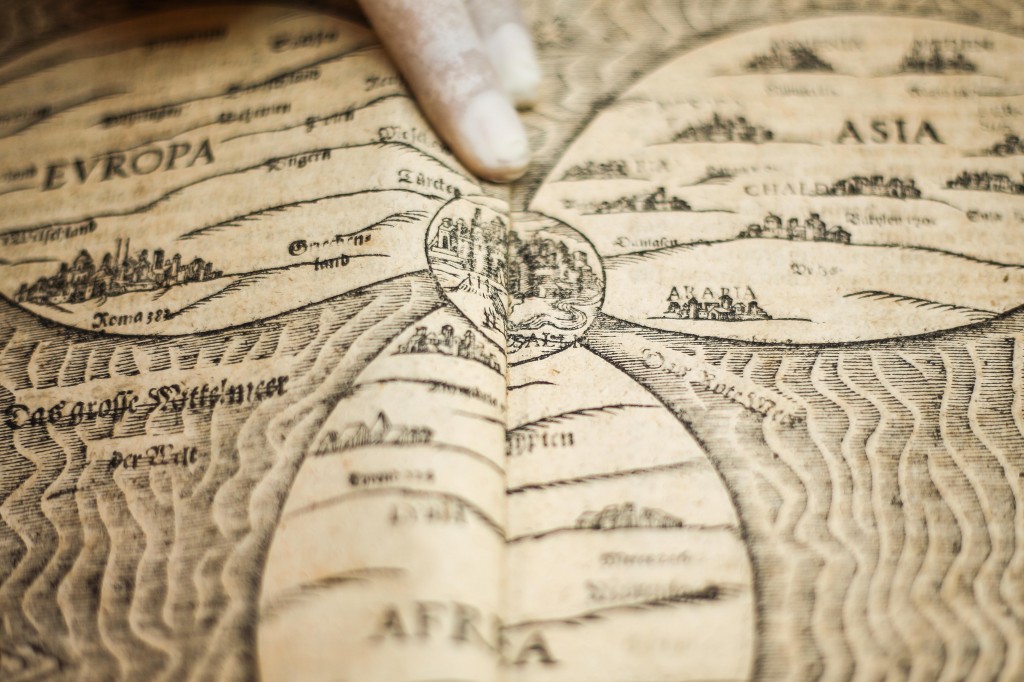Israel’s capital is a thrilling mosaic of Arab and Jewish, ancient and modern that will have to remain united, even when it becomes the capital of two countries.
When Israel’s War of Independence came to an end, the young Jewish state breathed a sigh of relief. The war had ended and Israel was alive. Burying one percent of its population, wounded in flesh but invigorated in spirit, Israel had survived and even prevailed. The newborn state signed armistice agreements that expanded its borders far beyond that of the November 29, 1947 UN Partition Plan. Israel was in control of 78 percent of the land between the Jordan River and the Mediterranean Sea. Only 156,000 Arabs remained in its territory. The floodgates of Jewish immigration from Europe and the Middle East were opened.
But something was missing. The Old City of Jerusalem, the Jewish Quarter with all of its synagogues, the historic Jewish cemetery on the Mount of Olives, the Wailing Wall (as it was called back then), and the Temple Mount were beyond Israel’s reach and many Jewish holy sites desecrated and defiled. Like a body without a heart, the Jewish people’s sacred city was gone, fenced off behind walls and barbed wire.
The Old City fell early in the war on May 28, 1948. Some 2,000 Jewish citizens and 600 fighters surrendered to the forces of Jordan’s Arab Legion. The Old City and all of east Jerusalem were cut off from Israel until 19 years later. In June 1967, the eastern parts of the city were conquered together with the West Bank.
On June 7, 1967, two days after the Six Day War began, the IDF commander whose paratroopers took the Old City, Mordechai Gur, famously announced, “The Temple Mount is in our hands.” By the end of the six days all of Judea and Samaria—all the land between the river and the sea—were under Israeli control. All of Jerusalem was now in Jewish hands. A brave Israeli soldier raised the Israeli flag over the Dome of the Rock on the Temple Mount.
Defense Minister Moshe Dayan ordered that it be removed immediately. Dayan understood the explosive potential of raising the Israeli flag over the third most holy place in Islam. Jews from all over Israel rushed towards Jerusalem to enter the Old City and parade through its winding alleys to the Wailing Wall, but before entering the gates of the Mount they encountered a sign already placed by the Chief Rabbinate warning them not to enter.
The Temple Mount is Judaism’s most sacred place, yet ironically, some orthodox Jews claim that Jews should be forbidden to enter it. No one can determine the exact location of the “Holy of Holies,” the place where Jews believe the divine presence would descend in the final moments of the closing Ne’ilah prayers on Yom Kippur, when the High Priest of the Temple would plead for forgiveness and compassion on behalf of the people. The prohibition seeks to avoid any desecration of this most holy place. But the Temple was destroyed. There is no High Priest, and according to the highest authorities in the religious establishments of the State of Israel and the Haredi world, the Temple will only be rebuilt after the coming of the Messiah. So until the Messiah arrives they say, Jews should not enter the Temple Mount at all. That remains the mainstream halacha accepted by some Orthodox Jews in the Holy Land and around the world.
Immediately after the 1967 war, the Knesset voted to extend Israeli law to east Jerusalem. It also expanded the boundaries of the city by annexing 17,400 acres of land, of which 1,500 had been the boundaries of Jerusalem under Jordanian rule from 1949 to 1967, as well as large tracts that had been ‘no man’s land’ – never held by Jordan, but off limits by military cordon and inaccessible to Jews during those years. Jerusalem was declared the eternal united capital of the State of Israel and the Jewish people.
The removal of the physical border that existed from 1949 to 1967, however, did not remove the geopolitical and demographic border between the two Jerusalems, and in a crucial sense, Israeli leaders have imparted a false hope to their people, to Jews around the world, and to the entire international community about the unity of Jerusalem. There is most definitely an Israeli-Jewish Jerusalem just as there is an Arab-Palestinian Jerusalem, though the divide is not east-west. The first recognition of this came as a semi-official declaration from the man most credited for Jerusalem’s unification, former long-time Jerusalem Mayor Teddy Kollek. When the first intifada broke out at the end of 1987, he said “Coexistence in Jerusalem is dead,” and admitted, “We really have done nothing for the Arabs,” recognizing the reality that Israel had reclaimed a large amount of land and built new Jewish neighborhoods on it—without investing more than a minimal amount of money in developing the Palestinian areas of Jerusalem.
Today, there is a Jewish majority in the areas annexed to Israel, and the Palestinians have become a minority in the area commonly referred to as “east Jerusalem.” Since the signing of the first Oslo agreement in September 1993, the divisions between the two Jerusalems have become more distinct. It is incorrect to speak about east Jerusalem as Palestinian and west Jerusalem as Israeli. Today it would be more correct to speak about Israeli Jerusalem and Palestinian Jerusalem.
Despite the reality of two Jerusalems, the notion of a unified Jerusalem is still celebrated by most Israeli politicians, political parties, Jewish public figures, and Jews around the world. Israel’s annual celebration of the “reunification” of Jerusalem is marked each year with an Israeli flag parade through the city’s Jewish, mixed and Arab neighborhoods, ultimately entering the Old City through the Damascus Gate in the heart of the Muslim Quarter. YouTube clips of the 2012 Jerusalem Day parade show some marchers chanting “Mohammed is Dead,” “Jerusalem for the Jews,” “Death to Arabs,” and other slogans even more grotesque. On the day celebrating the reunification of Jerusalem, it could not have been more vivid just how divided the city really is.
The odd thing about the myth of a united Jerusalem is that, in reality, the some of the same people who believe in the notion demonstrate by their own behavior that Jerusalem is divided. Most Israelis do not visit the Arab parts of Jerusalem, with the exception of the Old City, and even this is visited in much smaller numbers than in the past. Israeli Jerusalemites have never even heard of some of the Palestinian neighborhoods in Jerusalem. And it is doubtful how many Israelis would be willing to fight and perhaps die so that those areas can remain forever part of the united, undivided, eternal capital of the State of Israel and the Jewish people. We chant “If I forget thee, oh Jerusalem,” and cannot even imagine chanting, “If I forget thee, oh Um Tuba, let my right hand wither”; or “By the waters of Babylon, we sat and wept when we remembered thee of Jabel Mukaber”; at our Passover Seders, we do not say “Next year in Walaja.”
Our memories of Jerusalem and our current images of Jerusalem do not include the Palestinians. When I think about this, I wonder why it is so important to keep the modern myth of unity alive. What does seem important to me and, I think, to most Israelis, is that the city remain physically open, without walls separating and dividing it.
Palestinian Jerusalemites are no different. For them, Jewish Jerusalem is foreign territory. On more than one occasion, I have sat with an Israeli Jerusalemite together with a Palestinian Jerusalemite and asked them to describe the city. A foreigner would never know that they were speaking about the same city. When I invite Palestinians from east Jerusalem to visit me at my home in Kiryat Hayovel in southwest Jerusalem, I have to give them directions on how to reach my home, as if they were not from Jerusalem at all.
The truth is that Jerusalem is the most segregated city in the world. There are very few areas in the city that can be described as “shared” between Israelis and Palestinians. When I was a member of a committee of experts on Jerusalem that Prime Minister Ehud Barak created between the Camp David summit of July 2000 and the Taba summit of January 2001, we sat around a huge aerial photograph of Jerusalem and were able to draw lines that completely separated Israelis from Palestinians. Virtually every building in the city can be identified as either Israeli or Palestinian. This is even true for Jerusalem’s Christian institutions. The St. Louis French Catholic Hospital opposite the New Gate of the Old City is a Catholic “Israeli” institution. Right next door to the hospital is the Notre Dame Jerusalem Center which is a Catholic “Palestinian” institution. How does one know? If you call the Hospital you will be answered in Hebrew. There are many Israeli employees in the hospital. All of the signs in the hospital are in Hebrew and French. You can even get a kosher meal in the French Catholic hospital. Next door, in the Notre Dame you will be answered in Arabic. All of the employees are Palestinians and foreign Catholics. All of the signs are in Arabic and English.
There are very few sites in Jerusalem, perhaps only two, that can be described as shared. One is the promenade in Armon Hanatziv, from which there is a spectacular view of the Old City of Jerusalem. When Israelis and Palestinian walk the promenade and look at the amazing view, they are each seeing what they believe to be their heritage—which is, in fact, completely different for both sides. Jews look towards the southern Old City walls and the Temple Mount, and see the city during the time of King David. Palestinians see the village of Silwan leading to the Al Aqsa Mosque, with the third holiest site in Islam on the Haram a-Sharif—the Noble Sanctuary from which Mohammed ascended to heaven to receive the Quran. They see the same landscape and imagine a completely different picture based on completely different national and cultural narratives.
The other places shared in Jerusalem are the hospitals. When the human body demonstrates its frailty, it doesn’t matter what your nationality is or what religious beliefs you hold. It doesn’t matter if the doctors are Jews or Arabs, only whether they are good at what they do. Israelis and Palestinians meet in Jerusalem’s hospitals as equals. This is certainly a credit to Israel and perhaps a window into other possibilities.
Yet Jerusalem cries from conflict. What a paradox for a city whose name means “city of peace” or “city of wholeness.” Every national, religious, and ethnic group in the city claims Jerusalem for itself. “Our Jerusalem,” as spoken by each different group, has little room for the inclusion of others in what is “ours.” This idea of a narrow “ours” is not necessarily a bad thing. We each want “our” Jerusalem to reflect our identity and to give a physical expression to how we see ourselves as a group—whether the group has a religious or national identity. But for Jerusalem to earn its name as a city of peace, we are going to have to think creatively. All of our separate pieces of Jerusalem—Israeli Jerusalem, Palestinian Jerusalem, Jewish Jerusalem, Muslim Jerusalem, Christian Jerusalem—can be thought of as a common, physically undivided space in which each separate identity has control (sovereignty where it applies) over their own lives within their own domain. The unity of Jerusalem can only become reality when we cease to fight over its separate pieces.
This conceptualization of separate pieces making a whole is difficult for us to grasp, mainly because of the feeling that if we don’t control it all, we will not be safe in any part of it. But as long as we fight over them, Jerusalem will never become the inspiration for the world that it has the potential of being. Both national groups must recognize that ours is not the only legitimate claim to the city’s past, present, or future. Jerusalem is the most important city to both Israeli and Palestinian national identity. It is a city of profound religious importance to all three monotheistic faiths. A solution to the conflict between Israel and the Palestinians must include the creation of two capitals in Jerusalem. The only way to realize this vision is to recognize that the physical openness of the city must remain. All Jerusalemites and visitors to Jerusalem must have the freedom to move from one part of city to another without crossing physical borders. Without this, Jerusalem will not survive as a place where people want to live and raise their families.
In 1975, during the final months of my year-long course with Young Judaea, we were sent out once a week to discover Jerusalem on foot. Our journeys were almost exclusively limited to Jewish Jerusalem. On one of these outings, my group was sent west from Mount Scopus with the assignment to document as many of the city’s subcultures as we could. We had to visit at least five distinct neighborhoods and knock on doors in order to see what music people listened to, what food they cooked, where they came from, and how they identified themselves. For me, these outings were the ingredients that fed my love for Jerusalem. I quickly came to the realization that what made Jewish Jerusalem so special was that it was a mosaic. Jewish Jerusalem is a collection of diverse elements that, put together, become a finely tuned composite of different colors, smells, and tastes held together in a frame called Israel.
Wandering off on my own, I also discovered the Palestinian side of Jerusalem. When I moved to Israel in 1978, I stayed with a religious friend in Ramot. Being secular myself, I decided that I wanted to go out and explore. From my friend’s window I could see the nearby Palestinian village of Beit Hanina. It looked so pastoral and even biblical that I had to go and see it on foot. It looked very close from my friend’s window, but proved to be much further away over several high hills and deep valleys.
The village of Beit Hanina is a small rural community that is not part of the Jerusalem municipality. But it is still connected to Jerusalem, and its people see themselves as Jerusalemites. The main road of the village leads to the much more urban Beit Hanina neighborhood, which is part of Jerusalem. I walked through the main street of this sleepy village, probably the first Israeli civilian who had been there in a long time. Everyone stared at me. I saw a coffee shop and decided to stop and sip the local brew. My broken Arabic was enough to open people’s hearts, and they welcomed me in. Sitting with the men in their traditional dress, I sipped my coffee and talked about the various accents of Arabic that exist within Jerusalem’s Palestinian communities. I then boarded a Palestinian bus and went to Salah-a-Din street, the chief urban thoroughfare of east Jerusalem. This is Palestinian Jerusalem’s main commercial district. It was all so different to me, so foreign, yet all so Jerusalem.
Salah-a-Din street is a busy shopping area filled with boutiques, shops selling home goods and appliances, currency exchangers, fast food and mini-markets, book stores, travel agencies, and more. It is a normal commercial street like any other in the Arab Middle East. It is completely foreign to the Jewish downtown triangle of Ben Yehuda, Jaffa, and King George Street; only a mile apart, they are culturally in a different country. Salah-a-Din is all hustle and bustle and great hummus. My favorite hummus eatery is Abu Ali, a little place in an alley just off the main street. I have eaten there more than a hundred times and have never seen another Jew there.
From there I walked to the Old City of Jerusalem—the heart of the city, the place that appears in almost everyone’s mind when they think of Jerusalem. The Old City is divided into quarters—Jewish, Armenian, Christian, and Muslim. The various groups living in the city’s non-Jewish quarters are mixed together. Only the Jewish Quarter is made up of one community—Jews. This was codified in a decision by Israel’s Supreme Court, Burqan v. Minister of Finance (1978), a lawsuit brought by a Palestinian family that originally lived in the Mughrabi Quarter, located on what is today the huge open plaza in front of the Western Wall. The Mughrabi Quarter had some 135 homes that were bulldozed by Israel on June 11, 1967. When the construction of the Jewish Quarter began, a member of one of the displaced families, Mohammed Burqan, tried to purchase an apartment there and was turned down. His petition to the Israeli Supreme Court was rejected. The Court refused to allow Burqan the right to purchase a home because the area had “special historical significance” to Jews, which was held to supersede all other claims by non-Jews. Today, Jews live in all four quarters of the Old City, having reclaimed Jewish properties owned prior to 1967, and Arab citizens of Israel have the same right as Jews to live in the Jewish Quarter. In fact, according to census figures more Arabs live in the Jewish Quarter than Jews in the Muslim Quarter. Yet Palestinians who are not citizens of Israel and hold permanent residency status may live only in the other three quarters of the Old City.
When I was discovering Jerusalem, I decided that I would make a list of all of the bus routes in the city, including those that served Arab neighborhoods, and spend one day a week riding them. It was my goal to travel every route in the city. I would board and disembark at whim, whenever something attracted my attention. Most of the routes were designed to serve specific neighborhoods and connect them to the city center. The buses seemed to be cross-sections of Jerusalem’s various communities on wheels, but with very limited diversity. They seemed to be planned so as to minimize contact and friction between different groups. That is in fact how much of Jerusalem functions. Its residents don’t usually cross borders. Work environments sometimes mix them together, but not often. Schools are also somewhat mixed, but within well-defined borders. There are secular schools, national religious schools, and ultra-Orthodox schools. The Arab schools have their own diversity—municipal schools, church-affiliated schools, private schools, Islamic schools, and even UN schools for refugees.
In 2010, however, the Jerusalem light rail changed the transportation map of the city and opened a door to social interaction that never existed before. Instead of circling around neighborhoods and taking people to the center, this urban tram bisects the city from northeast to southwest. As a result, it is not uncommon to witness Palestinian women standing in a crowded tram car next to ultra-Orthodox Jewish men, young Ethiopian Jews coming into contact with Russian-speaking Israelis, or me, a secular Israeli born in New York, enjoying every second of Jerusalem’s wondrous mosaic.
In 2010, Jerusalem launched its light rail, and for the first time Jerusalemites from all walks of life—Palestinians, Russian and Ethiopian immigrants, ultra-Orthodox Jews—all had to share the same public space.
The problem with Jerusalem’s mosaic is, of course, the desire on the part of many to have other parts of it removed. Many times in my 33 years living in Jerusalem, I have heard people say they wish that certain parts of the population would simply disappear. It is not always Jews complaining about Arabs or Arabs complaining about Jews. Often the complaints are from within the different communities themselves. Jews against Jews and Palestinians against Palestinians. There are times when the conflicts seem so intense that one almost sees Jerusalem’s diversity as a curse.
The most apparent clashes are, of course, the Israeli-Palestinian conflict and the religious-secular conflict, which is perhaps more accurately defined as the ultra-Orthodox versus other Jews conflict. More than twenty years ago, when I went in search of a home in Jerusalem, my choices were extremely limited. I did not want to live in the north of the city, which was becoming increasingly ultra-Orthodox. I did not want to live in any of the new neighborhoods built over the Green Line in what is inaccurately called “east Jerusalem.” Although Israelis call these residential areas neighborhoods, the Palestinians and much of the world see them as settlements, built in violation of the Fourth Geneva Convention. As the founder and co-director of a joint Israeli-Palestinian think-tank, I decided that I could not live in a disputed part of Jerusalem.
The natural place for me to live would have been Bak’a or the German Colony in the south of the city. These neighborhoods have a very small ultra-Orthodox population. They have a diverse mix of Ashkenazi and Sephardi communities, as well as many English-speaking Israelis. They also have many Arab homes owned by Jews. In fact, the nicest homes in these neighborhoods were owned by Arabs before 1948. I also could not bring myself to buy one of these, both for financial reasons—they are very expensive—and reasons of principle. My co-director, Palestinian journalist and peace activist Hanna Siniora, was born in Bak’a. In 1948, his family fled to the Old City. After the war, his home was in the newborn State of Israel, and he was living on the other side of the border in Jordanian-occupied east Jerusalem. He saw his home nineteen years later, which was occupied by a Jewish family from Morocco.
I ended up buying an apartment in the southwest neighborhood of Kiryat Hayovel, a working-class area established in the 1950s for the wave of new immigrants who arrived after the 1948 war. It is a mixed neighborhood that has gone through a gentrification process over the last 15 years, with more young people moving in. Last year, we got our first sushi restaurant, a health food store, and a gourmet delicatessen. There have been repeated attempts by ultra-Orthodox communities to establish themselves in our neighborhood. These attempts at Hareidi expansion have met swift local organization, demonstrations, and the community’s determination not to upset the neighborhood’s delicate balance. Kiryat Hayovel is typical of many Jerusalem neighborhoods, in that almost but not quite everything is closed on the Sabbath. Along with families singing the traditional zemirot, you will hear televisions tuned in to the Friday night news. On Saturday afternoon, many people walk or drive to Teddy Sadium for the soccer match. Kiryat Hayovel is very much a live-and-let-live neighborhood, careful not to harm the status quo according to which we can all live together in peace.
The Simon Wiesenthal Center of Los Angeles is currently building a Museum of Tolerance in the center of Jerusalem, which its founders state will be a
multifaceted educational institution and social laboratory in the heart of Jerusalem that speaks to the world and confronts today’s important issues—like global anti-Semitism, extremism, hate, human dignity, and responsibility, and promoting unity and respect among Jews and people of all faiths. A place that teaches that greater than any external threat is the internal divide that separates, and reinforces the idea that Jewish unity is not a slogan, but an essential recipe for survival in the 21st century.
This sounds like a nice idea, of course, and as the center of Jewish existence, Jerusalem is a good place to locate such a museum. But this Museum of Tolerance has been the source of controversy, being built in this city of many layers atop what was once a Muslim cemetery, part of which was paved over to build a parking lot in the mid-1960s. The controversy this has triggered has been a vivid demonstration of the challenges presented by Jerusalem and the challenges facing Jerusalem.
Jerusalem should become the world’s center of tolerance and understanding. But we can only create that reality by beginning to understand the blessings of Jerusalem’s diversity and the emotional, historical, and religious attachment that so many communities across the planet feel towards the city.
Several years ago, while taking some visitors to the Old City, we were confronted with one of Jerusalem’s beautiful realities. It was Passover for Jews, Easter for Christians, and Ramadan for Muslims—all at the same time. The Old City was congested with both locals and visitors from all over the world coming to celebrate their own holidays in the holy city. In order to catch our breath, we stepped inside a small shop. Parades of people in traditional clothing moved past us like a human wave. A large group carrying an enormous cross passed a group of ultra-Orthodox families eating matzoh sandwiches. It was almost surreal. We heard the call to prayer in the distance, and shopkeepers in the Muslim quarter closed their stores and left to pray. It was an amazing scene. I could have stayed there for hours, watching Jerusalem nearly at its best.
Jerusalem should be the world’s center of tolerance and understanding. But for that to happen, we need to embrace its diversity and all the attachments that the world feels towards the city.
I say “nearly” because Jerusalem would be at its best if, within each celebration of a group’s heritage and holidays, there were people from the other groups celebrating with them. The Palestinian Minister of Religious Affairs, who is also the Minister of the Islamic Trusts, told me that as the chief official responsible for all Muslim holy places in Palestine, he has absolutely no problem with Jews going to the Temple Mount (haram a-sharif) and even praying in the al-Aqsa Mosque. He told me that Sharia Law does not prohibit it. He also said, however, that in today’s political context, in which there is a battle for control of Jerusalem, it is simply impossible, and could even be seen as an act of war against the world’s one billion Muslims. Just think about that for a moment. If peace were made, Jews would be able to safely ascend the Temple Mount and even pray inside the mosques there. But right now, that same act has the potential of causing a cataclysmic disaster.
When Jerusalem truly becomes a city of tolerance and understanding, it will be a beacon to the whole world. More than 150 countries will establish their embassies in the city. Those embassies could, in principle, be accredited to two states. Jerusalem as a city of tolerance could become a center for the world’s international organizations. There are some 45 such organizations based in Geneva, all of which could be invited to relocate their headquarters to Jerusalem. In addition, the world’s three monotheistic religions could create centers of learning and understanding that use theology and religious beliefs to celebrate diversity.
Jerusalem would fulfill its potential. From Zion would go forth the light of understanding, tolerance, and peace. This is only a vision, but it could become a reality. It is that vision that keeps me in Jerusalem. It is this dream of the celebration of diversity that continues to intrigue me and inspire me to continue to love Jerusalem.
![]()
Banner photo: silverjohn/123RF






